Yellow and white is not common color scheme in snakes. The snakes of these colors are small in number and, in most cases, caused by special conditions like albinism or other mutation or bred to be that way. The lack of yellow and white colors in snakes might be because those particular colors together do not help much in camouflaging.
A lot of yellow and white snakes are pythons which are very famous as pets. Because of their popular demand, reptile breeders breed pythons with specific genes to make uniquely colored specimens.
In this article, we’ve discussed 20+ yellow and white snakes in detail and listed the other few. Here they are:
List of 20+ Yellow and White Snakes
1) Yellow or Mango Corn Snake
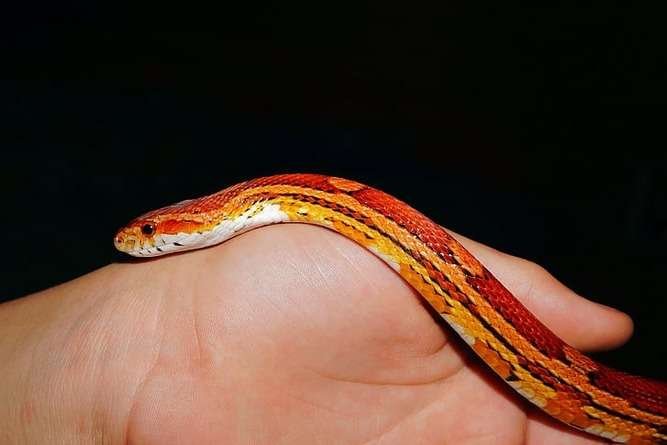
We’re starting the list of yellow and white snakes with Corn Snake. It is a species of nonvenomous snake found mostly in the USA and some in Australia. Since the majority of their distribution includes America, they’re known as American Corn Snakes.
There are various color patterns for this species. One of them is the candy-cane color morph, also known as the amelanistic corn snake. In this color morph, the skin of the snake is white with yellow and orange patterns on it. Most of the patterns are on the back, leaving the belly side totally white.
Yellow or mango corn snake morphs have reddish-yellow to yellow/golden color blotches down their back with a whitish or albino base. These are nonvenomous and have pink or red eyes. They’re semiarboreal and great climbers.
Mango Corn Snakes forms are mostly for petting purposes. They have slender build and lacks heat-sensing pits.
- Scientific name: Pantherophis guttatus
- Common names: Butter mothley corn snake, mango corn snake, High yellow corn snake
- Size: 2–5 feet.
- Location: southeastern and central United States, abundant in Florida.
2) Ball Python
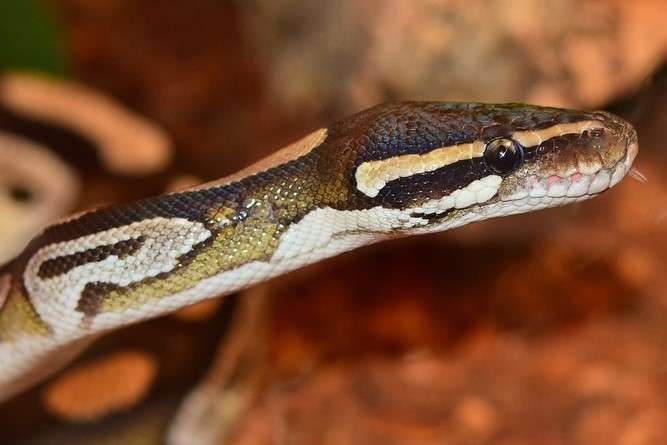
Ball Pythons are African python species and the smallest one of them. This species of python is very popular as pet. The snake tends to curl into a ball when stressed or threatened, leading to its name. It also shows aestivation, which is similar to hibernation but occurs in summer.
The ball python has numerous color morphs and is bred to create new, unique morphs. One of the natural morphs of this python is white with yellow patterns on the back. The front is white, and the eyes of the snake are red.
- Common Name: Royal Python
- Scientific name: Python regius
- Size: 6 feet
- Location: Benin, Cameroon, Chad, Central African Republic, Ghana, Guinea-Bissau, Guinea, Ivory Coast, Liberia, Mali, Nigeria, Senegal, Sierra Leone, Sudan, Uganda
3) Reticulated Python
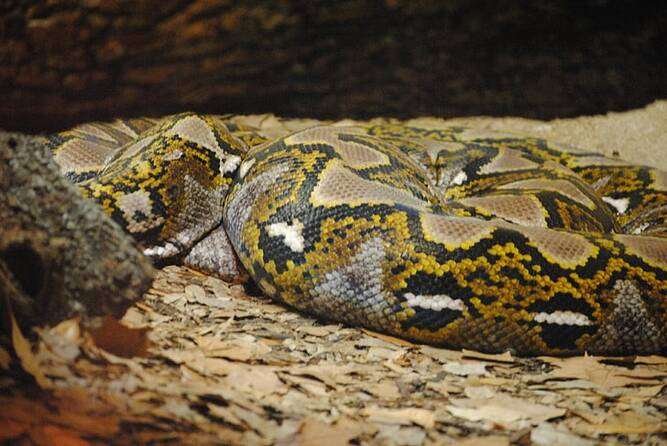
Reticulated Pythons are the longest snakes in the world as well as one of the heaviest. Its length can reach up to an astounding 21 feet.
Like every other python, the reticulated python is also a nonvenomous snake that subdues its prey by constricting. This python can be dangerous to humans as it is capable of killing by constriction or eating them.
This huge python primarily has four colors in its color scheme. The body of the snake is covered with tan patterns on the back with black borders.
Towards the edges, the skin is gold-colored with silvery dome-shaped patterns. There are small white marks inside the black markings and near the edges. The ventral side is completely yellow.
- Scientific name: Malayopython reticulatus
- Size: 4 ft 11 in – 21 ft 4 in
- Location: Bangladesh, Cambodia, India, Indo-Australian Archipelago, Indonesia, Laos, Malaysia, Myanmar, Philippines, Singapore, Thailand, Vietnam
4) Albino Burmese Python

The Burmese Python is another large python that can grow up to 16 feet long. This is also a nonvenomous constrictor, very popular as a pet, especially in the USA.
Due to overharvesting, this species suffered from habitat loss and experienced an almost 30% population decline in a few years, which is why it is listed as a Vulnerable species in the IUCN Red List.
The natural color of Burmese pythons is gold and brown, similar to the coloring of Indian pythons. But there are some albino specimens of the species that are found in nature.
The albino Burmese python lacks melanin which causes its body to be light yellow with bright yellow and white patterns on it. The belly side of the body is completely white.
Albino Burmese Python is one of the largest specie of snakes in size. These morphs are albino or white with different patterns of butterscotch yellow and burnt orange.
They inhabit Rainforests near streams, grasslands, swamps, and rocky foothills. Their diet consists of birds, mammals, rats, and mice. Their large bodies help them suffocate their prey by coiling around them and squeezing them till it dies.
They’ve powerful, stretchable jaws that help them in swallowing prey up to 5 times huge as their head. These snakes are good climbers and excellent swimmers.
- Scientific name: Python bivittatus
- Common names: Asiatic rock python, tiger python, albino python
- Size: 16–23 feet
- Location: native to Southeast Asia, Florida
5) Albino Monocled Cobra
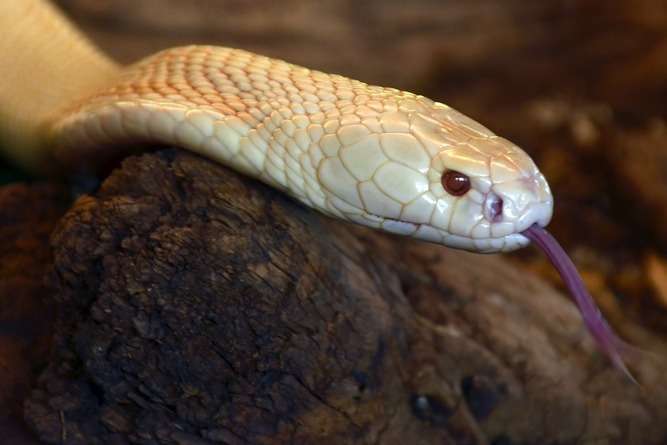
Finally, we have a venomous snake on this yellow and white snake list. The monocled cobra is an average-sized snake found in south and southeast Asia.
The venom of this cobra species is very potent and lethal. It contains neurotoxins that lead to paralysis and even death due to respiratory failure.
The normal colors of the monocled cobra consist of brown, yellow, gray, and black. But the albino monocled cobra is mostly white. The hood of the snake is yellow with a characteristic round pattern in orange and pale yellow.
The rest of the dorsal side is a combination of yellow and white, while the ventral side is completely white.
- Common Name: Monocellate Cobra, Indian Spitting Cobra
- Scientific name: Naja kaouthia
- Size: 158 – 230 centimeters
- Location: Bangladesh, Bhutan, Cambodia, China, India, Laos, Myanmar, Nepal, Thailand
6) Moluccan Python
Moluccan Python is a large python species endemic to Indonesia. It is nonvenomous and a constrictor snake species. Due to its small geographical range and steady habitat loss, this snake species has been listed as Near Threatened in IUCN’s Red List of Threatened Species.
The color scheme of moluccan pythons includes yellow, black, and white. The back of the snake is bright yellow with black patterns on it. The head is a murky brown with a gold tint. The ventral side is white.
- Common Name: Yellow Python
- Scientific name: Simalia clastolepis
- Size: 8 – 9 feet
- Location: Indonesia
7) Yellow Biak Green Tree Python

The Yellow Biak Green Tree Python is native to the Biak Island of Indonesia. These snakes are from the green tree python species, different only by the color of the skin.
As its name suggests, the snake is of a bright yellow with small dot-like white patterns on it, bordered by a dark or pale brown. The eyes of this snake are unique, with a slit pupil and brown and yellow striped iris.
The yellow biak green tree python is average-sized for a python. It’s nonvenomous but has a feisty attitude and is prone to attack. It suffers from smuggling and trading worldwide, though it is still a Least Concern species according to the IUCN Red List.
- Scientific name: Morelia viridis
- Size: 5 – 6.6 feet
- Location: Biak Island of Cenderawasih Bay in Indonesia
8) Albino Lavender Reticulated Suntiger Python
Albino lavender reticulated pythons have a reticulated, net-like pattern; hence, it’s named “Reticulated” python.
The original forms are widely distributed and hunted for their skin for medicinal purposes, but the albino one is used for selling as pets because of their beautiful pastel coloration.
They have yellow color background scales with golden and silver linings and ruby-red eyes. The reticulated python lives in rainforests, woodlands, and nearby grasslands.
It is also associated with rivers and is found in areas with nearby streams and lakes because of their great swimming skills. Despite their aggressive and intimidating appearance, these snakes are easygoing and make suitable pets.
- Scientific name: Malayopython reticulatus
- Common names: lavender ball python
- Size: 4–21 feet.
- Location: South and Southeast Asia
9) Pied Ball Python
There’s another ball python in this yellow and white snakes list. This time it is the Pied Ball Python which is another color morph of the ball python with a special mutation. These snakes are specially bred by reptile breeders by mixing particular genes.
Pied ball python is a unique-looking snake, though its color scheme varies. In some, the whole body is white, from neck to tail. Only the head is gold & black colored. In others, the body is golden-yellow, black and white, which is why it is one of the most expensive snakes.
- Scientific name: Python regius
- Size: 3 – 5 feet
- Location: Africa
10) Albino Red Tail Boa
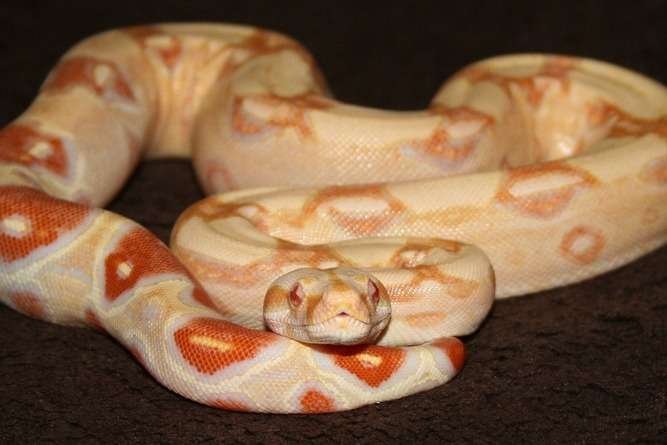
The Red Tail Boa is a large snake species that primarily resides in South America. This nonvenomous snake hunts its prey by striking and grabbing it between the jaws before suffocating the prey. The name of the snake comes from the red pigmentation at the tail.
Red tail boa has several color morphs. One of those is pigment disorder, i.e., albinism. Albino red tail boa has colored string-like patterns with white as the background color. Two-thirds of the patterns, starting from the head, are yellow, while the patterns near the tail are orange-red.
- Common Name: Boa Constrictor, Red-Tailed Boa
- Scientific name: Boa constrictor
- Size: 3 – 13 feet
- Location: Colombia, Ecuador, Peru, Venezuela, Trinidad and Tobago, Guyana, Suriname, French Guiana, Brazil, Bolivia, Uruguay, Argentina, other islands of South America, southern Florida, St. Croix is US Virgin Islands
11. Albino Ball Python

Albino Ball Pythons have an albino color base with yellow color markings of different percentages. These are prime examples of yellow and white snakes.
These pythons have yellow color blotches on the back and sides. They inhabit grasslands, shrublands, and open forests. In addition, these tend to curl their body, forming a ball-like shape when frightened, so they’re named “Ball Python.”
They’re not a wild type and are only bred for Humans petting purposes. Because of their lighter distinguished color, they become prone to many dangers if introduced in the wild and can die quickly out of illness.
- Scientific name: Python Regius
- Common names: Royal python, Royal albino python
- Size: 3–6 feet
- Location: West and Central Africa
12. Banana Ball Python
Banana ball python shares a similar appearance to albino python, but they’ve darker eyes and more silvery/gray color as their secondary color; they also have banana-colored splotches along the body.
Its background scales color ranges from golden-yellow to yellowish-orange. It has very tiny black color spots which look like freckles.
- Scientific name: Python Regius
- Common names: Coral glows, White smokes
- Size: 3–5 feet
- Location: Western to Central Africa, north of the equator
13. Albino Honduran Milk Snake
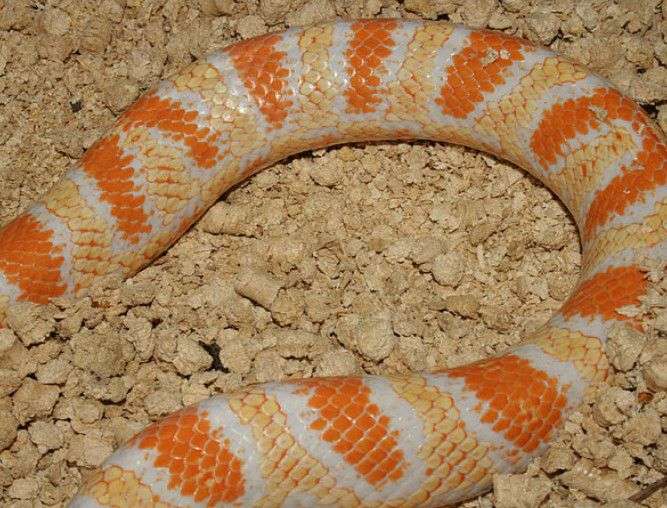
Albino Honduran Milk Snake morphs have a base color of red which is very reduced in albino morphs; they have three colored stripe patterns.
In these morphs, there are alternating yellow, white/albino, and red bands, which gives them a very majestic look. They’re a tropical species, so they need a higher humidity level.
- Scientific name: Lampropeltis triangulum hondurensis
- Common names: Albino Honduran Milk Snake
- Size: up to 5 feet
- Location: Honduras, Nicaragua, and Northeastern Costa Rica
14. Albino Northern Pine Snake
Albino northern pine is a beautiful yellow and white color snake. They’re ponderous snakes with white, tan, or yellowish background color and have peach-red color markings throughout.
Their head is small and somewhat pointed. The pine snake inhabits pine flat woods, sandy pine-oak woodlands, prairies, cultivated fields, open brushland, and rocky desert. They’re excellent diggers and like to spend most of their time in underground burrows.
- Scientific name: Pituophis melanoleucus
- Common names: bull snake, pilot snake, horned snake
- Size: –7.9 feet (40–90 inches)
- Location: southeastern United States
15. Albino Western Hognose Snake
Albino western hognose snakes are relatively stout and meager in appearance. They’ve white or albino base bodies with butterscotch/yellow color small circles lined by orangish-red color circles.
These circles look more like big spot marks. This snake gets its common name, “hog nose,” from the modified rostral (nose) scale that is formed in an upturned manner, providing a very “hog-like” look.
These snakes inhabit areas with sandy or gravelly soils. Though Hog nose is indeed venomous, they’re not very dangerous to humans because their fangs are tiny, they don’t produce much venom, and their bites don’t cause many symptoms in humans.
- Scientific name: Heterodon nasicus
- Common names: albino hognose snake
- Size: 1.3–1.7 feet (15–20 inches)
- Location: southern Canada throughout the United States to northern Mexico
16. Albino Timber Rattlesnake
Albino Timber Rattlesnakes are very rare- ‘one in a million.’ They are large venomous pit vipers having impressively large fangs and high venom production.
These have a single dark yellow or golden color stripe running from their head down toward the tail. Albino Timber Rattlesnakes have an off-white body; they’re not entirely albino and have veins-like stripes arising from the main mid-line.
These snakes have a group of hard, loose scales that are shed over time, towards the end of their tails called rattle, that produces a sound as a warning before the snake strikes and also to scare off or distract its potential prey.
- Scientific name: Crotalus horridus
- Common names: albino timber rattlesnake, canebrake rattlesnake, or banded rattlesnake
- Size: 91–152 cm (36–60 inches)
- Location: eastern United States from southern Minnesota and southern New Hampshire, south to East Texas, and North Florida
17. Eyelash Viper
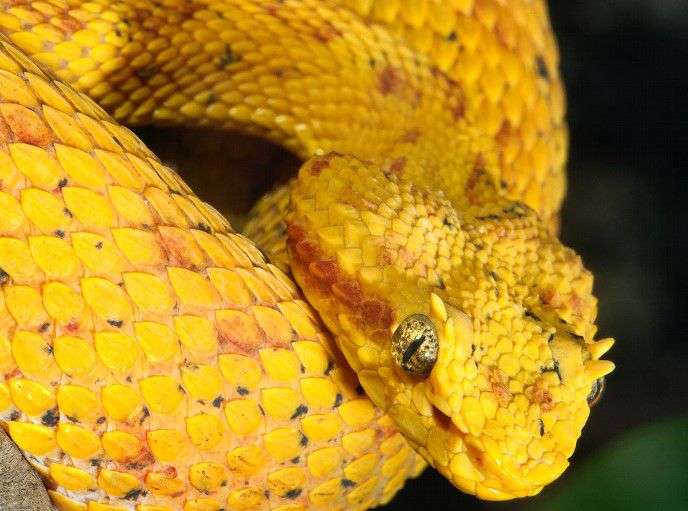
Eyelash viper specie is characterized by superciliary, enlarged scales above the eyes, which gives them the appearance of an eyelash. These are brawny animals, arboreal in nature, and have a strong ‘prehensile tail.’
These are venomous snakes and have long, hollow fangs, and their bite can be deadly and painful. Their eyes have vertically placed pupils.
Eyelash Viper have a very bright golden yellow color, but some have white color on their bellies. Their albino morphs are somewhat white with little yellow color blotches and markings. These are nocturnal creatures.
- Scientific name: Bothriechis schlegelii
- Common names: eyelash pit viper, eyelash palm viper, eyelash lancehead, etc
- Size: 55–82 cm (22–32 inches)
- Location: native to Central and South America
18. Albino Military Ground Snake
Albino military ground snakes are stout and muscular in appearance and have relatively small tails. It inhabits aquatic and riparian habitats. Their diet primarily consists of amphibians (including eggs and tadpoles), but also fish, and even lizards.
A morph of this species which is total albino was found in the Atlantic forest. It has strikingly looking golden to yellow color skin, which is distributed uniformly and has an albino white base. Sexual dimorphism is seen in these animals, where females are more extensive than males.
- Scientific name: Erythrolamprus miliaris
- Common names: military ground snake, water snake, smooth snake, cobra lise, culebra
- Size: 50 cm ( 20 inches)
- Location: endemic to South America
19. Erythristic Kingsnake
Erythristic king snakes are a morph of Floridian King snakes. They have a variety of patterns that may vary from zigzag band lines to stripe bands.
They also have very fine darker color markings or red or orange color on them. These have dark golden color blotches with an albino base. They look a lot like their relative hypomelanistic forms.
- Scientific name: Lampropeltis californiae
- Common names: Erythristic king snake
- Size: 60–152 cm (24–60 inches)
- Location: Southeastern Canada to southern Ecuador
20. Albino Western Diamondback Rattlesnake
Albino Western Diamondback Rattlesnakes morphs have a color pattern of golden-yellow and white-albino. Their bases are of white color but are little seen under its beautiful diamond patterned golden looking back.
These diamond shapes are highlighted by dark linings, which look well-shaped over white background scales.
- Scientific name: Crotalus atrox
- Common names: Albino Western Diamondback Rattlesnake
- Size: 4–7 feet (120–200 cm)
- Location: southwestern United States and Mexico
21. Desert Horned Viper
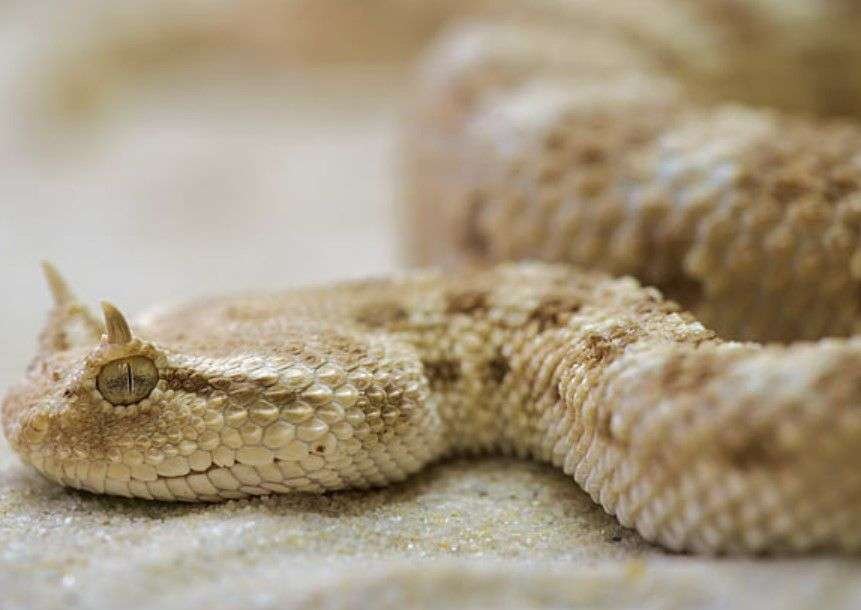
Desert Horned Vipers are small, sturdy, and broad-headed. They have a pale yellowish, pinkish, or brown muddy color of skin. They match the substrate on which they’re found.
These have horns that protect their eyes from harsh conditions such as sandy environment and also helps them in camouflaging.
- Scientific name: Cerastes cerastes
- Common names: Saharan horned viper, desert horned viper
- Size: 30–80 cm (12–30 inches)
- Location: Iraq, Syria, Saudi Arabia, Yemen, Jordan, Israel, Kuwait, North Africa, Libya, Egypt, and Sudan
This article on yellow and white snakes ends here. As we see in this article, the majority of yellow and white snakes are either caused by mutation or specially bred. That is why the number of such specimens are significantly less than other color schemes.
Let us know if we missed one from the list and also your thoughts on the piece. And if this article interests you, then you may like our similar articles on animals. We will be back with another article, till then read FAQs mentioned below.
Frequently Asked Questions
1) What are the names of the pet yellow and white snakes?
Ans. Ball Python, Burmese Python and Corn Snakes are often kept as pets.
2) What does dreaming of yellow and white snakes mean?
Ans. Dreaming about yellow and white snakes represents obstacles in life and also the possibility to overcome them.
3) Are yellow and white snakes venomous?
Ans. Most of the yellow and white snakes are pythons and they are nonvenomous. But the albino monocled cobra is a venomous snake that has yellow and white skin due to its albinism.
Also Read:

Hey there! I’ve been the kid who used to love watching all the science stuff and that fascination lead me to choose Zoology as my Major in Graduation. I’m a self-taught writer and spend my time writing scintillating content on animals. I love observing animals behavior and their bond with humans. I want to give my point of view regarding animals i research about. I had done several projects on animals during my graduation and learned their behavior thoroughly.
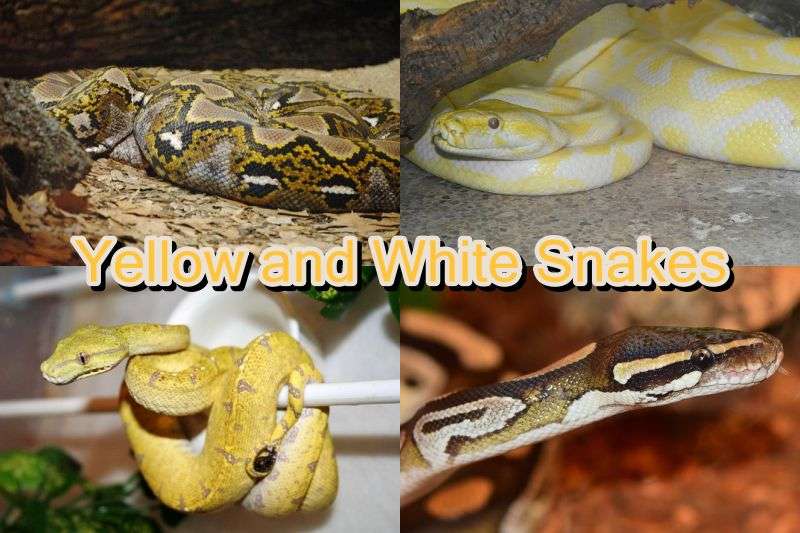
Comments are closed.